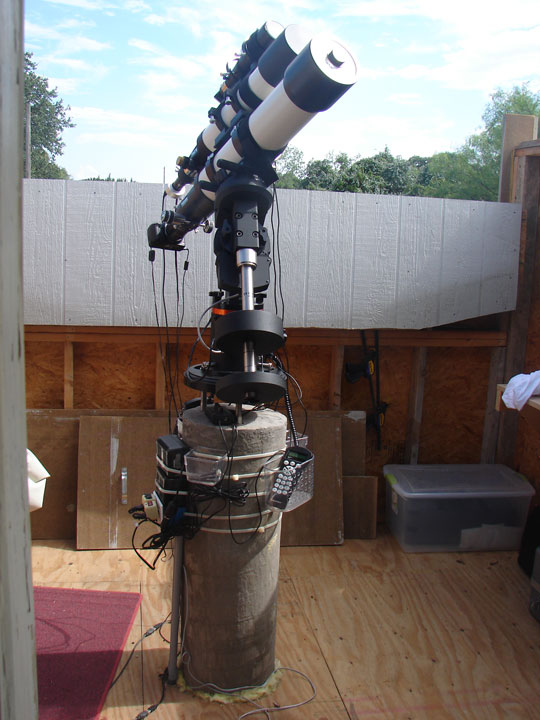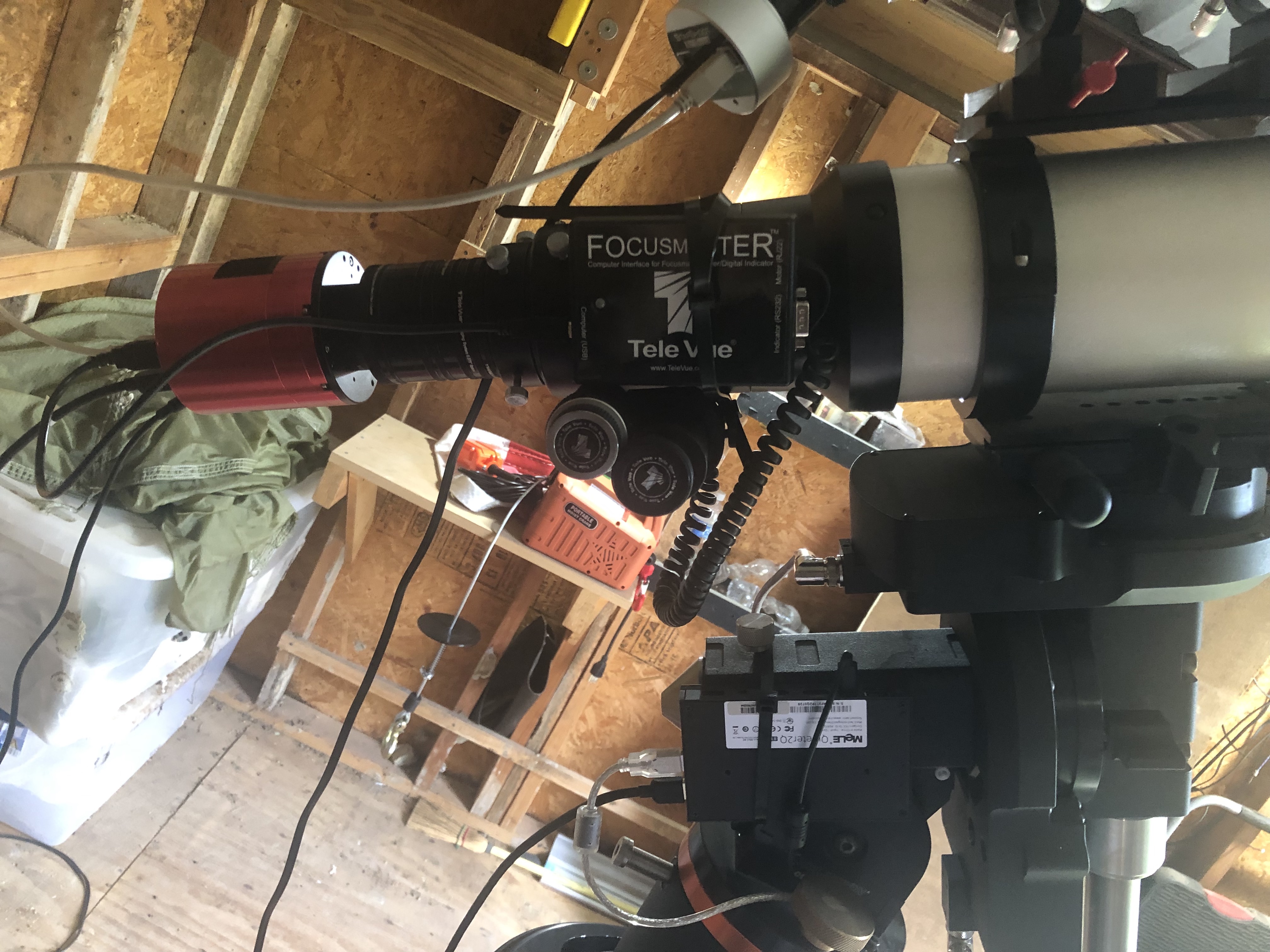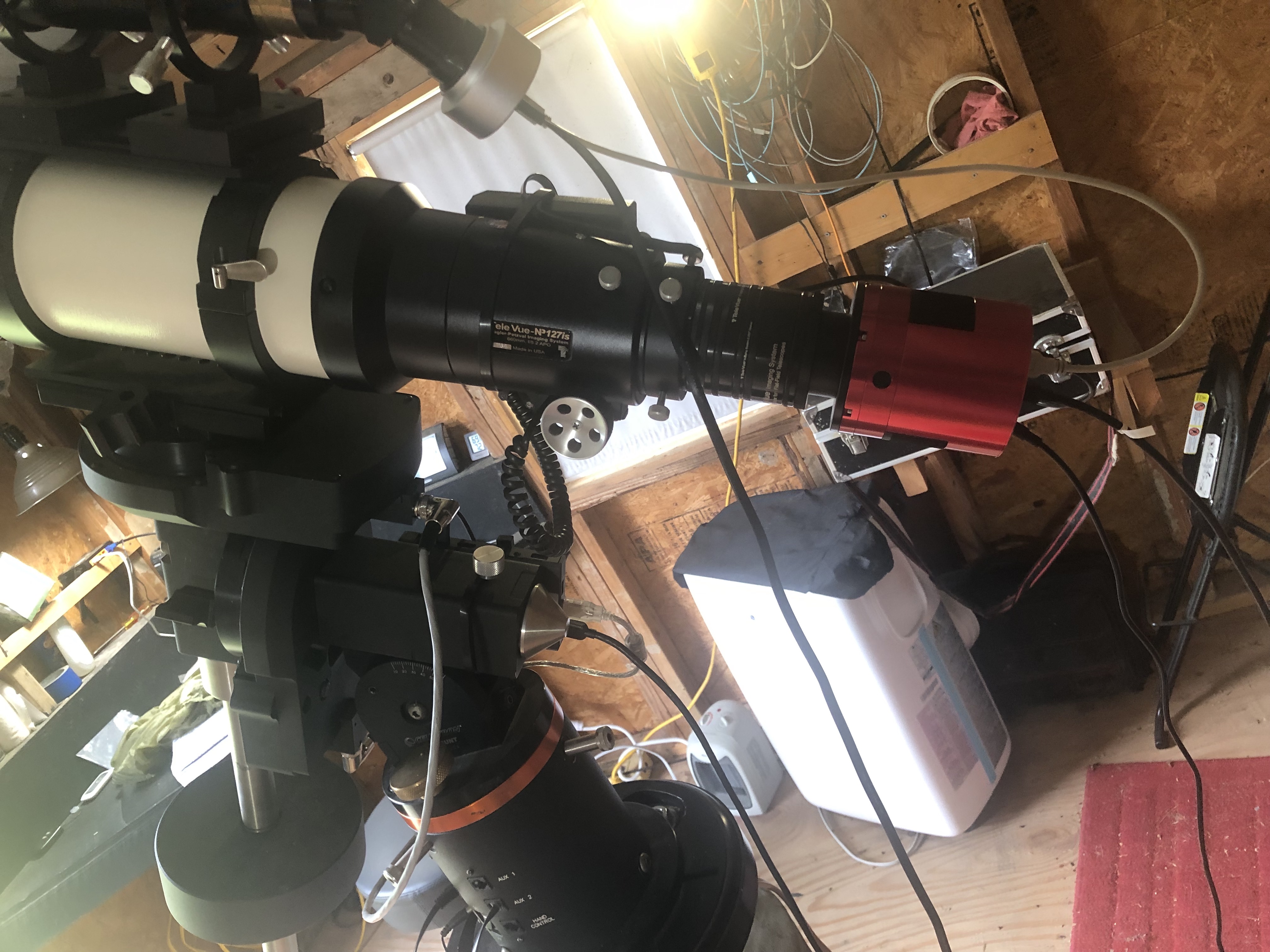
Inside the Observatory (Photographs and some of the description is old -see CURRENT SETUP near bottom of page)
The pier mounted Celestron CGE German Equatorial mount is used with a Televue NP-101 (since sold) or a Televue NP-127is. Shown below is the TV NP-127is, TV NP-101 used as a guide scope, and a TV 60 for visual spotting. A Hutech modified Canon 450D (now a 600D) is the primary camera for AP. An Orion StarShoot AutoGuider is used with Stark Labs PHD2 Guiding software (free-ware for both Mac and PC although the StarShoot will work with a PC only). The most used configuration is to mount the TV NP-127is first and then have the scopes shown below riding piggy-back. Now the camera is mounted to the TV NP127is and the StarsShoot to the TV-60.
The work station consists of a single Intel Mac notebook running both OS X and Windows XP. A large external LCD monitor is used for focusing but can be used for other applications best viewed on a larger screen. Both the laptop and external monitor are covered with rubylith film for night vision adaptation. The laptop is on a wireless LAN and once the telescope and peripherals are turned on, the entire operation can be monitored/operated remotely from the house using TeamViewer software (free-ware for both Mac and PC). Using TeamViewer, new targets can be acquired remotely as well as operate the cameras. For aquiring new targets, I have found it works best to have a second laptop just for this purposed although the Intel Mac will work using a USB hub. The reason for using two is I sometimes need to run in both Mac and PC modes simaltaneously. I find that running a program like VMware Fusion is not as easy as just using an older MacBook.
MY General AP Night Acquisition Procedures/Routine:
1. Turn all essential equipment on and open roof. It takes about ten minutes to open the roof, connect the computer, uncover the scope, and wake it up from hibernation.
2. Flats, bias and darks are taken before skies are dark enough for AP. I focus both the main scope and guide scope (TV NP101 or TV 60) using a Bahtinov focus mask (along with Bahtinov Grabber freeware for a PC) and a large LCD screen with Canon's EOS utility (comes with camera for both Mac and PC) set on live view (certain models) at 10x. I found it is possible to use the 4+" mask on the TV-60 by balancing the mask by one screw on the top of the scope.
3. Target is acquired using the CGE hand controller, The Sky 6 (PC only), Voyager 4.5 (both Mac and PC), or Stellarium (free-ware for both Mac and PC).
4. Canon's EOS utility is started and short ISO 1600 shots are taken to ensure the target is positioned as desired.
5. PHD Guiding is initiated and monitored until guiding is established.
6. ImagesPlus Camera Control is then used to take the desired exposure and sequence of sub-frames. I usually set a 45"to 60" delay between shots to allow the CCD to cool a bit between subs. I also routinely turn a fan on low with it blowing directly at both cameras.
7. Progress is monitored at the observatory or from the house depending on the weather and other factors. One can use TeamViewer (free-ware for both Mac and PC) for remote monitoring. If your house is not too far from your observatory or set-up site, an N-router works great as it has a good coverage range. Be sure to set some type of wireless security if close to streets or other houses.
8. Close-up time takes about five to ten minutes.
See Ray Shore's or Covington's site for a detailed discussion on setting up your DSLR.
New Equipment Setup as of 4/2023: ZWO ASI2600mc Pro and Mele Quiteter 2 mini PC running Cartes du Ciel and N.I.N.A. to control the camera, focuser (Rigel Systems nStep), guider (Orion Starshoot or ZWO290mm), PhD2, and Celestron CGE Mount. Only the Televue 60 and NP127is telescopes are now being used.



N.I.N.A. profile for TV FocusMaster and Celestron CGE with Nexster+ hand controller:
Focuser - ASCOM DeviceHub Focuser
Telescope - ASCOM Celestron Telescope
DSLR Astrophotography without a telescope (focusing a DSLR for wide-field AP)
t......@gmail.com